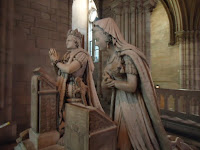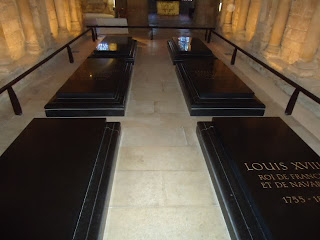Patron Saint of France, and the House of Bourbon
Attributes in art: His own head. Sometimes shown with a palm branch, symbol of martyrdom.
Feast Day: Oct 9

St. Denis was decapitated. Then in a flash of glory he stood up, picked up his head and carried it more than two miles to the place where he finally dropped.
This begs the question. Decapitation is Beheading, right? Shouldn’t that be DEheading? Shouldn’t BEheading be the act of placing a head ON and DEheading the act of removal? I think so. You’d certainly never say “Becapitated.”
But anyway, back to St. Denis: there is confusion as to when he lived. Some historical evidence suggests that perhaps his story is the melding of the legends of two bishops, one a protégé of the apostle Paul, who became the first bishop of Athens, and the other who lived a couple of centuries later. The French have historically argued that he was Paul’s protégé (to enhance the prestige of having him as their patron?). In either case, he was a bishop sent to the wilds of Paris in either 50 or so A.D., or a couple of hundred years later, depending on which version you trust, where he did a lot of good and angered the heathens who cut off his head, starting this whole headless walking thing.
The Cathedral of St Denis is located in the north of Paris on the spot where St Denis expired and was buried. A visit there shines a light on a moment of French history which the modern French seem to find a little cumbersome to explain or even examine.
During the Revolution, hordes ransacked and pillaged churches and abbeys throughout the land, but wreaked a particular vengeance on the Cathedral of St Denis, because it was the burial place of the Kings of France. For about 800 years, the Kings of France were laid to rest in uncharacteristic austerity there. Originally the tombs of the kings were simple marble sarcophagi in a row in the crypt under the altar with St Denis, their patron. Very cozy and convenient. However, with all the violence and upset of the 1790’s, the tombs were violated, their contents burned and desecrated in many creative ways. 

The Princes’ Crypt seems not to have been so badly disturbed and there you can still see some of the plain lead-lined, wooden caskets preferred by the French royals, and allegedly the heart of Louis XIV the very Sun King himself sits in a vial on the shelf.
In the 19th century, during the Restoration of the monarchy, Louis XVIII had all of the remaining remains placed in one room of the crypt and sealed with a common marker, and all the other stray royal tombs from remote churches and abbeys throughout France brought to St Denis as he attempted to reassert the power and majesty of the monarchy
He even had his brother, the be- (or rather, de-) headed Louis XVI and his lovely (also decapitated) Queen Marie Antoinette re-interred in the very spot where his ancestors had lain until the, um, disruption of the Revolution.

The Cathedral is beautiful even as cathedrals go, and it is difficult not to feel some reverence for the history of the place and the history caused BY many of those buried there but at the cathedral I was frankly disappointed in the paucity of depictions of St Denis himself.
There is one statue, way up high, in the dark, one great image in the stained glass, and one carving over the door to the crossing.
Though I'm not absolutely certain of this, my hunch is that during the 19th century restoration of the cathedral, someone, perhaps Louis XVIII himself, noted the sad irony of the headless patron saint and the headless royals inside, and had some of the images of St Denis removed, in the interest of good taste. I offer this potential explanation, as most cathedrals dedicated to a particular saint – especially where that saint’s relics are interred – contain many images of the eponymous saint, and as I have already mentioned, St Denis is conspicuously absent from his own cathedral.
So, despite Parisians’ disdain for the place (my innkeeper even asked “why for heaven’s sake do you want to go there??”) and the thrill of navigating the Paris Metro, for a history nut to pay his/her respects to generations of the rulers of one of history’s great nations, a visit to St Denis Cathedral is an almost overwhelming experience. If, however, you are looking to see great images of St Denis carrying his own head, you will be gravely disappointed.









I was unaware of the story of St. Denis. I guess my Protestant upbringing in a very Anglophilic place could be why. However, the cathederal sounds like a place I would enjoy. I pulled Shelly and Jager reluctantly into several open churches while we were in NYC. Like A. Warhol I think they are so pretty.
ReplyDelete